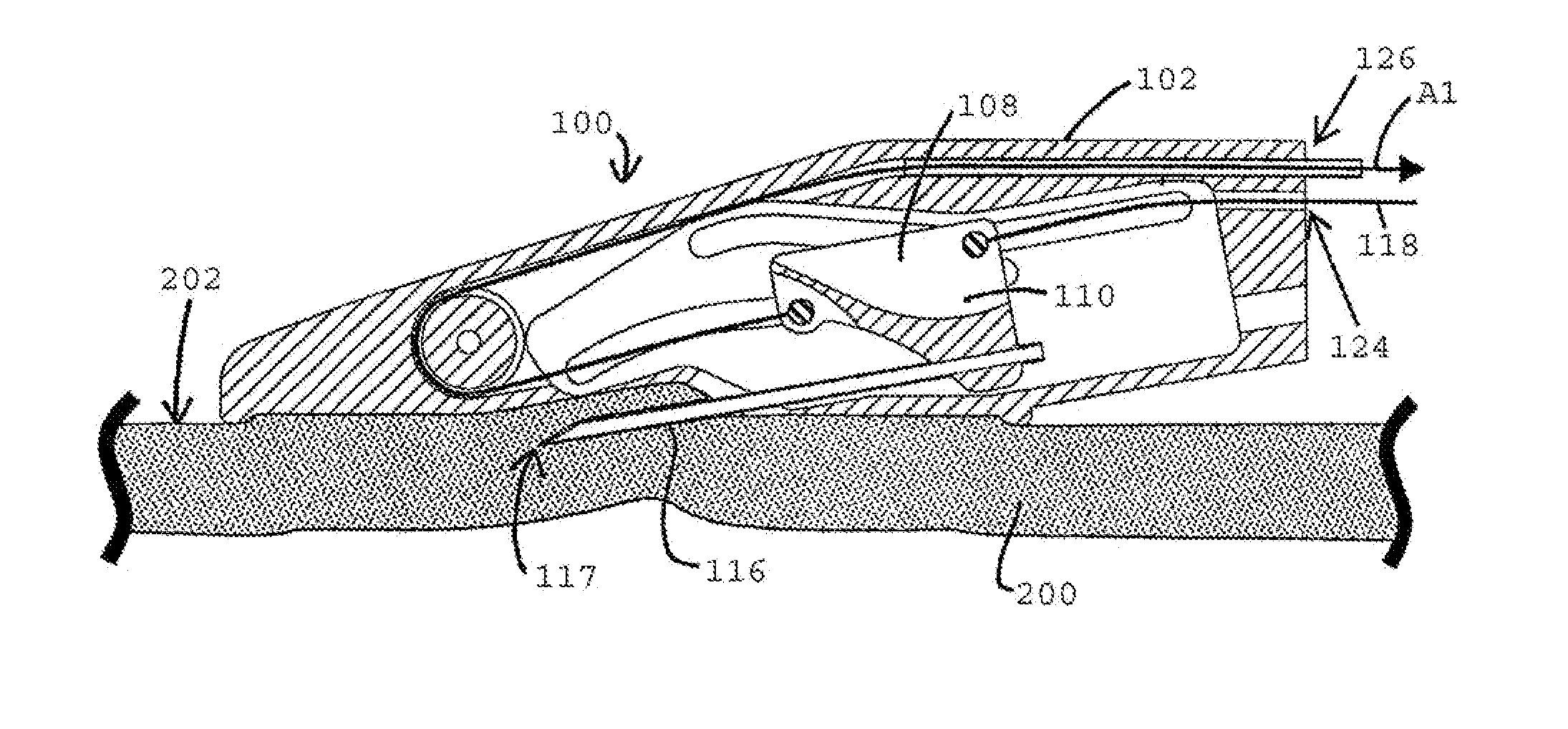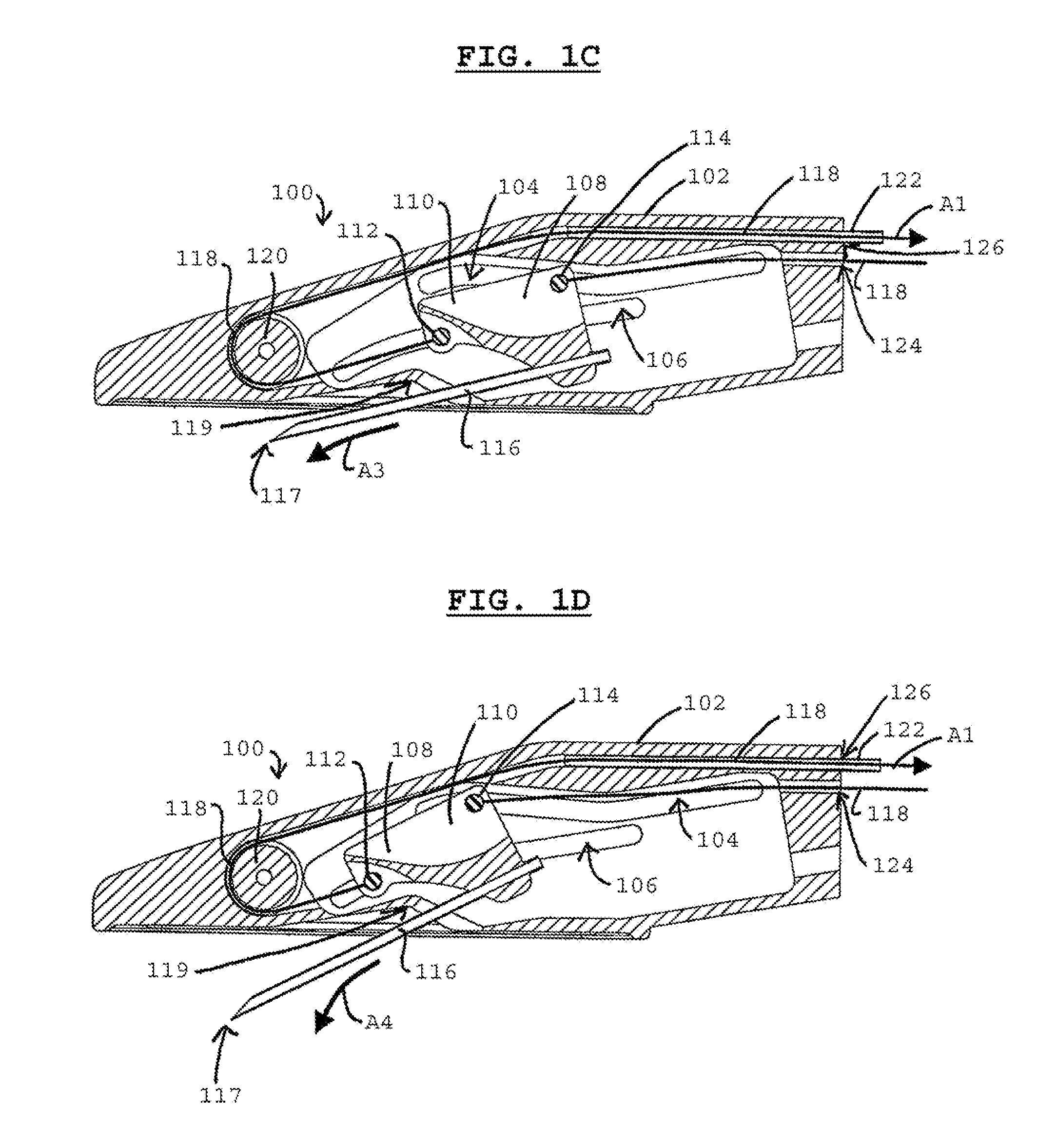[0005]In some variations, a device for forming one or more tracts in tissue may comprise a housing and a tissue-piercing member coupled to the housing, where the tissue-piercing member is movable relative to the housing along a path predetermined by one or more features (e.g., grooves) in the housing. The advancement of the tissue-piercing member along the predetermined path may allow for relatively controlled formation of a tract in tissue (e.g., requiring little manipulation of the device by the operator). For example, the presence of the predetermined path may allow for the tissue-piercing member to be well-positioned relative to the tissue prior to piercing the tissue.
[0007]Certain variations of devices described here may be relatively easy to use. For example, a device may be used to form a tract in tissue without requiring significant torquing or other manipulation by the operator. In some variations, a device described here may be successfully used by an operator who has had relatively little training, and / or who has had limited experience in the particular procedure at hand. For example, an operator who has had limited experience in forming an
arteriotomy may be able to use the device to successfully form an
arteriotomy. Devices described here may be unlikely to be misused. For example, in some variations a device may be actuated by simply pushing a button or operating a slide
actuator. Such simplicity in actuation may limit the likelihood of
confusion during operation of the device, and may also allow for operation of the device by operators having different skill levels. As an example, in some cases a device may be capable of operation by both a
highly skilled operator and a relatively inexperienced operator. Additionally, devices that are relatively easy to use may be
safer than other devices because, for example, they may result in a reduced likelihood of operator error.
[0008]In some variations, an operator may be able to operate a device described here at a distance from the body of the person undergoing the procedure, while having localized control over the advancement and / or positioning of the tissue-piercing member. For example, the operator may be able to actuate the device by manipulating a tensioning member that is coupled to the device, and / or by pressing or actuating one or more buttons, switches, etc., without significantly manipulating the body of the device itself. This, in turn, may prevent the operator from having to advance a long tissue-piercing member down a long tissue-piercing member port, in a tortuous or bending path, to reach a
target site. Such advancement can result in high frictional forces between the tissue-piercing member and the tissue-piercing member port, thereby requiring that the operator exert a substantial force to overcome the high frictional forces and advance or withdraw the tissue- piercing member. When the operator exerts the substantial force, the device and / or surrounding tissue may become damaged, and / or the tissue-piercing member may be over-advanced (e.g., because of initial
stiction that then releases unpredictably). Devices described here may avoid these problems by substantially eliminating the need to push and / or pull a tissue-piercing member along their length. Moreover, a tissue-piercing member may be actuated in tortuous positions without requiring that a bulky tissue-piercing member shaft maneuver the same tortuous path.
[0025]In some variations, a method for forming a tract in tissue (e.g., a vessel wall) of a subject may comprise forming a single tract in the tissue. The single tract may, for example, be self-sealing. As described above, a self-sealing tissue tract does not need interventional devices or methods to help it seal—by definition, it seals by itself. For example, a self-sealing tissue tract does not need a plug, energy, sealants, clips, sutures, or the like to help it seal. The single tract may be formed, for example, by advancing only one tissue-piercing member through the tissue. This may, for example, result in minimal stress on the tissue. Moreover, the tissue may recover relatively quickly, thereby resulting in relatively short
procedure time. In certain variations, the single tract may be used to provide access to a region defined by tissue, such as a lumen defined by a vessel wall. In some variations, a method for forming a tract (e.g., a self-sealing tract) in tissue (e.g., a vessel wall) of a subject may comprise forming a tract in the tissue by advancing at least one tissue-piercing member through at least a portion of tissue, where formation of the tract requires advancement only of the tissue-piercing member or members through at least the portion of the tissue.
 Login to View More
Login to View More  Login to View More
Login to View More 


